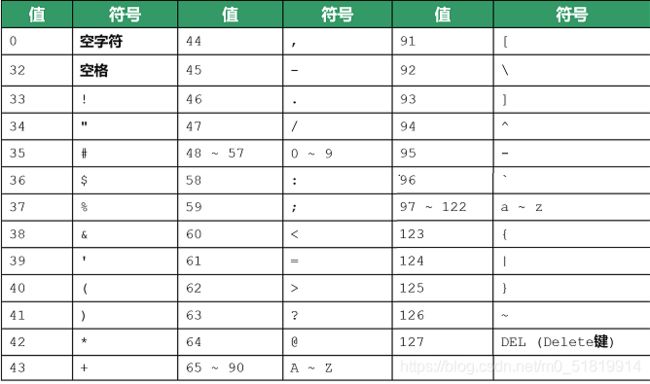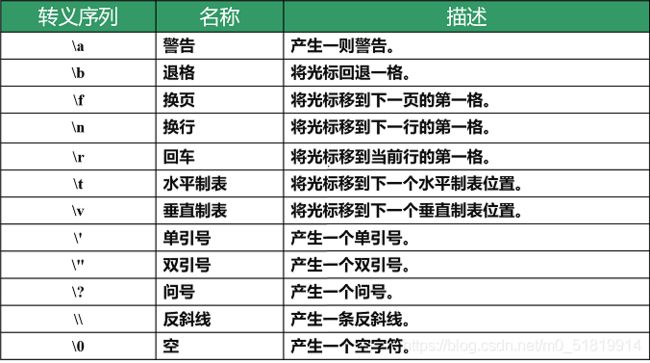C++课件知识点整理
C++课件知识点整理
- 第一章:C++简介
-
- 一.C++简介
- 二.文件扩展名
- 三.C++程序结构
- 四.C++中的注释
- 第二章:数据类型常量变量
-
- 一.数据类型(数据分类)
- 二.常量
- 三.变量
- 四.ASCII码表
- 五.转义字符
- 第三章:输入输出
-
- 一.C++输入输出(cin和cout)
- 第四章:运算符
-
- 一.算数运算符
- 二.关系运算符
- 三.逻辑运算符
- 四.赋值运算符
- 五.位运算
- 六.条件运算符
- 第五章:流程控制
-
- 一.条件语句
- 第六章:循环结构
-
- 一.循环
- 第七章:数组
-
- 一.数组
- 第八章:函数
-
- 一.函数
- 第九章:指针
-
- 一.什么是指针?
- 二.为什么要使用指针?
- 三.指针处理一维数组
- 四.小练习
- 第十章:函数高级
-
- 一.掌握函数参数的传递方式
- 二.使用数组作为函数参数
- 第十一章:字符串
-
- 一.C++ 字符串
- 二.字符串常用函数
- 未完待续...
第一章:C++简介
一.C++简介
C++是由 Bjarne Stroustrup 于 1979 年在贝尔实验室开始设计开发的
进一步扩充和完善了 C 语言,是一种面向对象的程序设计语言。
C++ 可运行于多种平台上,如 Windows、MAC 操作系统以及 UNIX 的各种版本。
最初命名为带类的C,后来在 1983 年更名为 C++。
二.文件扩展名
C++ 程序的源文件通常使用扩展名 .cpp、.cp 或 .c
开发流程
源代码-->编译器-->目标代码-->链接器-->可执行程序
/ \
启动代码 库代码
三.C++程序结构
#include //头文件包含了程序中必需的或有用的信息
using namespace std; //命名空间
int main() //主函数 程序从这里开始执行。
{
cout << "Hello World"; // 输出 Hello World
return 0; //终止 main( )函数 并向调用进程返回值0。
}
命名空间是 C++ 中一个相对新的概念。
为了解决合作开发时的命名冲突问题,
C++ 引入了命名空间(Namespace)的概念。
就好比一个软件由多个人合作完成,每个人各自做的部分命名什么都合适,
可是到时候把每个人的部分进行整合就会出现名字一样重复定义的问题,
所以有了命名空间的概念
用现实案例来说就是一个学校有好几个人都叫张三,这样不好管理,
那如果把他们分到不同的班级就不会冲突
自定义命名空间的格式:namespace关键字
namespace 名字{
}
四.C++中的注释
注释:解释说明的意思 用来做笔记用的 用来给我们程序员自己看的
//单行注释 只能注释掉双斜杠以后的当前行
/*多行注释*/ 只要写在斜杠星开始星斜杠结束的中间都可以被注释掉
//包含daoc++的标准输入输出头文件
#include 第二章:数据类型常量变量
一.数据类型(数据分类)
1.基本数据类型
整型 浮点型 字符型 宽字符型 布尔型 无类型
int float double char wchar_t bool void
字节: 4 4 8 1 2或4 1
位: 32 32 64 8 16或32 8
范围:
int:(-2147483648 到 2147483647)
float : 6~7位有效数字
double : 15~16位有效数字
char : -128~127 或 0~255
wchar_t: (-2147483648 到 2147483647)
bool : true false
2.typedef
可以使用 typedef 为一个已有的类型取一个新的名字
typedef int zhengshu; //给int取名为zhengshu
zhengshu distance; //使用新名字
//包含daoc++的标准输入输出头文件
#include 二.常量
常量是固定值,在程序执行期间不会改变。
这些固定的值,又叫做字面量。
比如pai = 3.124.. 已经规定好了
在 C++ 中,有两种简单的定义常量的方式:
使用 #define 预处理器。
使用 const 关键字。
#include三.变量
1.概念:可以改变的值,实质是内存的别名,
想要知道内存中存放变量的地址可以在变量名前加&符号
2.命名规则:
变量名可以由字母,数字,下划线组合而成必须以字母或下划线开头
C++语言中的某些词(main include等)成为保留字,具有特殊意义,不能用作变量名
C++语言区分大小写price和PRICE是两个不同的变量
#include#include#include四.ASCII码表
五.转义字符
第三章:输入输出
一.C++输入输出(cin和cout)
#include第四章:运算符
一.算数运算符
+ - * / % ++ --
#include二.关系运算符
(比较是否相等) != > < >= <=
#include<<(a < b)<<endl;
cout <<"a>=b:"<<(a >= b)<<endl;
cout <<"a<=b:"<<(a <= b)<<endl;
cout <<"a==b:"<<(a == b)<<endl;
cout <<"a!=b:"<<(a != b)<<endl;
return 0;
}
三.逻辑运算符
&& || !
#includef = " <<(e<f || d>f)<<endl;//1
cout <<"!(f > d) = "<<(!(f > d))<<endl;//0
return 0;
}
四.赋值运算符
= (赋值) += -= *= /= %=
#include五.位运算
&(按位与) |(或) ^(异或) ~(非) <<(左移) >>(右移)
/**
* 位运算符
* &(按位与) |(或) ^(异或) ~(非) <<(左移) >>(右移)
*
* 二进制
* 十进制转换二进制
*
* 13 二进制 1101
*
* 2048 1024 512 256 128 64 32 16 8 4 2 1 权次方
* 1 1 0 1
* 154 1 0 0 1 1 0 1 0
* 685 1 0 1 0 1 0 1 1 0 1
* 1250 1 0 0 1 1 1 0 0 0 1 0
* 243 1 1 1 1 0 0 1 1
* 684 1 0 1 0 1 0 1 1 0 0
* 60 1 1 1 1 0 0
**/
#include六.条件运算符
(三元运算符) 表达式1?表达式2:表达式3 -> 3>2?3:2
#include第五章:流程控制
一.条件语句
1.单分支if语句
如果...就...
if(条件){条件成立后我们要做的事}
2.if-else语句
如果...就...否则...
if(条件){条件成立后我们要做的事}else{条件不成立我们要做的事}
需求:判断用户年龄 如果年龄满18我们就输出 欢迎光临 否则输出 谢绝入内
#include3.if-esle if语句
如果...就...否则 如果(可能有多个)...就 ...否则...
if(条件1){条件1成立后我们要做的事}
else if(条件2){条件2成立后我们要做的事}
.可以有多个
else(前面所有条件都不满足我们要做的事)
需求:判断春夏秋冬
#include4.if嵌套
需求:如果分数大于60输出及格
否则如果小于60输出挂科
否则输出 谢天谢地
#include5.switch case
switch (值) {//整型 字符 Enum枚举
case 值:语句; break;
...
...
...
default:语句; break;
}
需求:判断春夏秋冬
1 2 3春
4 5 6夏
7 8 9秋
10 11 12冬
#include第六章:循环结构
一.循环
循环语句是由循环体及终止语句两部分组成,循环体就是要重复执行的操作
1.while循环
while(循环条件){循环操作}
特点:先判断,再执行
#include2.do while循环
do{循环操作}while(循环条件);
特点:先执行一次,再判断
#include3.for循环
for(1;2;3){4}
1.初始值(从几开始循环)
2.条件(boolean类型的结果)
3.每次循环对初始值的改变
4.循环体(重复要做的事情)
执行顺序:1 2 4 3 2 4 3 2 4 3 ...直到2条件不成立 循环结束
#include4.continue和break(通常与条件语句同时使用)
continue:继续下一次循环
break:跳出整个循环
#include5.各循环的无限循环
while(true){循环操作}
do{循环操作}while(true);
for(;;){循环操作}
#include
/*for (;true;) {
cout<<"a"<
/*for (;;) {
cout<<"a"<
/*while (1==1) {
cout<<"a"<
/*while (true) {
cout<<"a"<
/*do {
cout<<"a"<
/*do {
cout<<"a"<
return 0;
}
6.小练习
#include#include#include#include第七章:数组
一.数组
概念:连续等大的存储空间,类型相同的数据集合
定义:类型 数组名 [数组大小]
int arr[3]; //只定义不赋值
int arr1[3]={1,2,3}; //完全列举法
int arr2[3]={1,2}; //部分列举法
int arr3[]={1,2,3,4}; //省略大小列举法
如何访问数组元素:
通过数组下标来访问,数组下标从0开始
#include//循环给数组赋值
#include/**
* 对数组元素求最大值、最小值
*/
#include/**
* 冒泡排序:相邻的两个数字两两比较 较大的放在后面
* int [] x = {6,3,8,2,9,1};
* 从小到大排序:6 3 8 2 9 1-->1 2 3 6 8 9
*
* 第一趟:6 3 8 2 9 1
* 第一次:3 6 8 2 9 1
* 第二次:3 6 8 2 9 1
* 第三次:3 6 2 8 9 1
* 第四次:3 6 2 8 9 1
* 第五次:3 6 2 8 1 9
* 第二趟:3 6 2 8 1 9
* 第一次:3 6 2 8 1 9
* 第二次:3 2 6 8 1 9
* 第三次:3 2 6 8 1 9
* 第四次:3 2 6 1 8 9
* 第三趟:3 2 6 1 8 9
* 第一次:2 3 6 1 8 9
* 第二次:2 3 6 1 8 9
* 第三次:2 3 1 6 8 9
* 第四趟:2 3 1 6 8 9
* 第一次:2 3 1 6 8 9
* 第二次:2 1 3 6 8 9
* 第五趟:2 1 3 6 8 9
* 第一次:1 2 3 6 8 9
*
* 趟数=总数-1
* 次数为每趟-1
* */
#include第八章:函数
一.函数
1.理解:函数相当于一系列逻辑的集合
2.为什么使用函数:
使程序变得更简短而清晰
有利于程序为维护
可以提高程序开发的效率
提高代码的复用性
3.函数类型:
库函数
由C++语言系统提供
用户无须定义,也不必在程序中作类型说明
只需在程序前包含有该函数定义的头文件即可使用
自定义函数
用户在程序中根据需要而编写的函数
函数的定义
返回值类型 函数名 参数列表 函数体
void eat () {}
函数原型声明
在形式上与函数头部类似,最后加一个分号
原型声明中参数表里的参数名可以不写(只写参数类型)
#include
using namespace std;
int count(int,int);
int main(){
return 0;
}
int count(int x,int y){
return x+y;
}
函数的调用
通过在程序中使用函数名称,可以执行函数中包含的语句,称为函数调用
函数名(参数列表)
函数的形参和实参
形参:定义函数时的参数
实参:调用函数时传过来的参数
#include#include/*
根据边长计算长方形的周长及面积,用函数完成
函数定义:double getArea(double c){}
double getGirth(double c){}
*/
#include第九章:指针
一.什么是指针?
指针:专门存放变量地址的变量
指针变量声明的一般形式为:数据类型 *变量名=初始地址值;
指针运算符有&和*运算符
&:取变量的地址
*:取指针指向变量的内容
两者互为逆运算
#include
//指针变量需要先赋值,再使用
//dp = 2.5;//不允许把一个数赋予指针变量
int* f, g;
cout << "请输入一个数字:" << endl;
cin>>g;
f = &g;
cout << "你输入的数字是:" << *f << endl;
return 0;
}
星号是用来指定一个变量是指针。以下是有效的指针声明:
int i;
int *p = &i; 指针的类型必须与指针所指向的类型一致
int i;
int *p = &i;
int *q = p; 用已初始化指针变量做初值
int *ip; /* 一个整型的指针 */
double *dp; /* 一个 double 型的指针 */
float *fp; /* 一个浮点型的指针 */
char *ch /* 一个字符型的指针 */
注意:指针变量需要先赋值,再使用,不允许把一个数赋予指针变量
所有指针的值都是一个代表内存地址的长的十六进制数。
不同数据类型的指针之间唯一的不同是,
指针所指向的变量或常量的数据类型不同。
二.为什么要使用指针?
1.方便的使用字符串
2.有效地表示复杂的数据结构
3.动态分配内存
4.得到多于一个的函数返回值
三.指针处理一维数组
#include >a[i];
}
cout<<"输出a数组中的所有元素:"<
/*采用指针变量表示的地址法输入输出数组各元素*/
int i, a[10], * p = a;//数组名表示数组首地址->*p=&a[0];
cout<<"请输入十个数字组成数组a:"<<endl;
for (i = 0; i < 10; i++) {
cin>> *(p + i);//a[i]->*(a+i)
}
cout<<"输出a数组中的所有元素:"<<endl;
for (i = 0; i <= 9; i++) {
cout << *(p + i);
}
cout<<" "<<endl;
/*采用数组名表示的地址法输入输出数组各元素*/
int ii, aa[10];
cout<<"请输入十个数字组成数组a:"<<endl;
for (ii = 0; ii < 10; ii++) {
cin >> *(aa + ii);
}
cout<<"输出aa数组中的所有元素: "<<endl;
for (ii = 0; ii <= 9; ii++) {
cout << *(aa + ii);
}
cout<<" "<<endl;
/*采用指针变量表示的下标法输入输出数组各元素*/
int iii, aaa[10], * ps = aaa;
cout<<"请输入十个数字组成数组a:"<<endl;
for (iii = 0; iii < 10; iii++) {
cin>>ps[iii];
}
cout<<"输出aaa数组中的所有元素:"<<endl;
for (iii = 0; iii <= 9; iii++) {
cout<<ps[iii];
}
cout<<" "<<endl;
/*采用指针法输入输出数组各元素*/
int is, as[10], * pp = as;
cout<<"请输入十个数字组成数组a:"<<endl;
for (is = 0; is < 10; is++) {
cin >> *pp++;
}
pp = as; //重新将指针指向数组a的首地址
cout<<"输出as数组中的所有元素: "<<endl;
for (is = 0; is <= 9; is++) {
cout<<*pp++;
}
cout<<" "<<endl;
return 0;
}
四.小练习
#include第十章:函数高级
一.掌握函数参数的传递方式
C++语言中函数参数的传递方式有两种
1.值传递:实参传递给形参 对形参的操作 不影响实参
2.地址传递:实参地址传递给形参 对形参的操作 影响实参
#include二.使用数组作为函数参数
数组形式
指针形式
#include第十一章:字符串
一.C++ 字符串
C++ 提供了以下两种类型的字符串表示形式:
C 风格字符串
通常用一个字符数组来存放一个字符串字符数组末尾有一个空字符\0
C++ 引入的 string 类类型
#include 二.字符串常用函数
1 strcpy(s1, s2);
复制字符串 s2 到字符串 s1。
2 strcat(s1, s2);
连接字符串 s2 到字符串 s1 的末尾。
3 strlen(s1);
返回字符串 s1 的长度。
4 strcmp(s1, s2);
如果 s1 和 s2 是相同的,则返回 0;如果 s1s2 则返回大于 0。
5 strchr(s1, ch);
返回一个指针,指向字符串 s1 中字符 ch 的第一次出现的位置。
6 strstr(s1, s2);
返回一个指针,指向字符串 s1 中字符串 s2 的第一次出现的位置。
#include 
